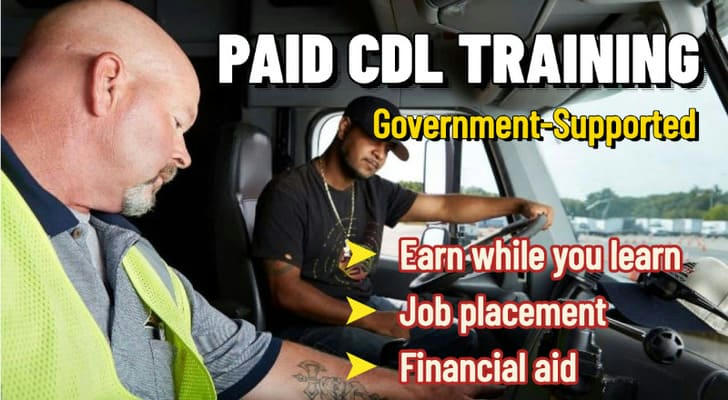Government-Supported CDL Training: Earn While You Learn with Job Placement Support
Government-Supported | Earn While You Learn | Job Placement
Government-supported paid CDL training programs create a cost-effective and career-focused pathway for aspiring commercial drivers. These initiatives combine hands-on instruction, financial assistance, and employment support, allowing trainees to gain a Commercial Driver’s License (CDL) while minimizing personal expenses.

1. Why Choose a Government-Supported CDL Training Program?
Government-supported CDL programs reduce financial barriers and enhance access to essential training. Most tuition costs are supported through federal or state workforce initiatives, such as the Workforce Innovation and Opportunity Act (WIOA), local employment subsidies, or employer-partnered apprenticeship programs that follow the “earn while you learn” model.
🔑 Key Advantages:
- Earn While You Learn — Many programs provide income support or stipends during training, helping participants maintain financial stability.
- Government and Employer Partnership — Backed by workforce agencies and carrier partnerships, ensuring industry-standard instruction.
- Job Placement Support — Programs often include direct job referrals or guaranteed interviews after certification.
- Reduced Training Costs — With WIOA grants or tuition reimbursement, out-of-pocket expenses are significantly lowered.
- Long-Term Career Pathways — Graduates can advance into specialized transport or logistics management roles.
2. Ideal Participants
| Age Group | Program Benefits & Focus |
|---|---|
| 18–24 (Young Adults) | Fast-track entry into the workforce with growth potential. |
| 25–40 (Career Transitioners) | Ideal for those changing fields or seeking stable income. |
| 41–55 (Experienced Workers) | Refresher training for compliance and skill enhancement. |
| 55+ (Career Re-entrants) | Flexible options for part-time or semi-retirement roles. |
3. Financial Assistance & Institutional Support
Participants may qualify for various federal, state, and institutional funding options designed to make CDL training more accessible:
- Workforce Innovation and Opportunity Act (WIOA) — Grants supporting job training and reemployment efforts.
- Veterans Affairs (VA) Education Benefits — GI Bill® and veteran-focused grants for eligible service members.
- Federal Student Aid (FAFSA) — Low-interest loans and grants available for qualifying CDL programs.
- State-Level Workforce Subsidies — Financial assistance through local employment agencies or transportation boards.
- Employer Tuition Reimbursement — Some carriers reimburse tuition after a defined service period.
4. Eligibility & Program Requirements
| Course Type | Overview & Admission Requirements |
|---|---|
| 160-Hour CDL A Course | Comprehensive training with classroom, range, and road sessions. Must be18+, pass aDOT physical, and hold a**Temporary Instruction Permit (TIP)**. |
| 80-Hour Accelerated Course | For students with prior driving experience. RequiresTIPandDOT medical card. |
| 40-Hour Refresher Course | For previous CDL holders updating skills. Must have held aCDL A or Blicense. |
| CDL BP Course | For Class B Passenger endorsement. Must be18+, passDOT physical, and obtainTIP. |
5. Application Process
- Research Approved Providers — Find certified CDL schools through state workforce portals or FMCSA listings.
- Gather Documentation — Prepare ID, medical certificate, and learner’s permit if applicable.
- Apply for Financial Aid — Check eligibility for WIOA, FAFSA, or VA funding.
- Submit Application — Complete online or in-person applications through official channels.
- Attend Training and Certification — Complete the program, pass licensing exams, and receive career placement support.
6. Success Stories
- Carlos, 24 (Texas): Used WIOA funding to enroll in a state-sponsored CDL A program. After certification, he joined a regional logistics firm and now earns a steady income with benefits.
- Tina, 38 (Veteran, Florida): Utilized VA education benefits to transition from military service to civilian trucking. Within a year, she was promoted to a lead driver position.
- Robert, 46 (Ohio): Took advantage of employer tuition reimbursement to reenter the industry after 10 years. His CDL renewal led to a supervisory logistics role.
- Employer Partnerships: Many carriers report higher retention rates among graduates of government-supported programs due to improved training quality and job readiness.
